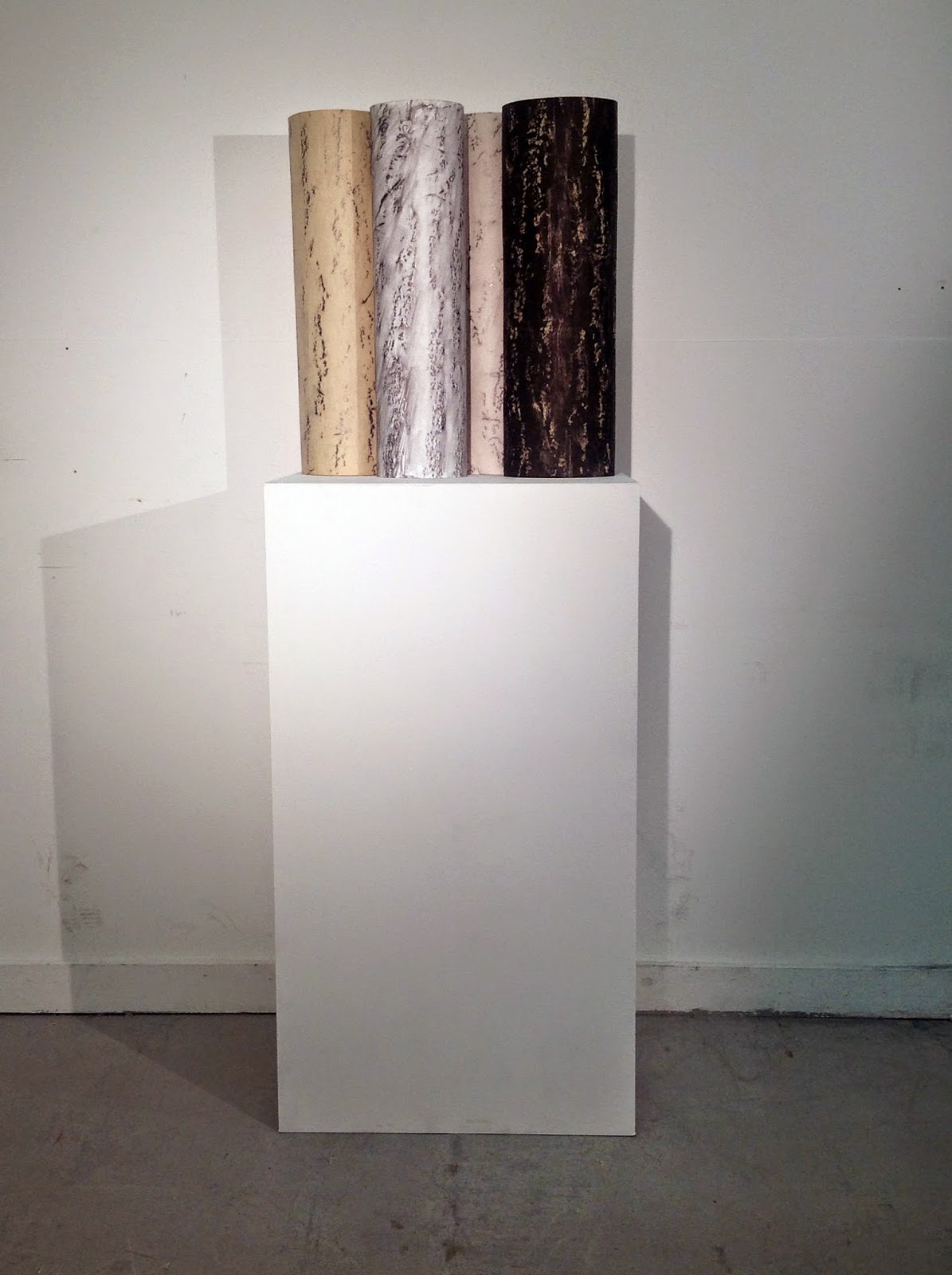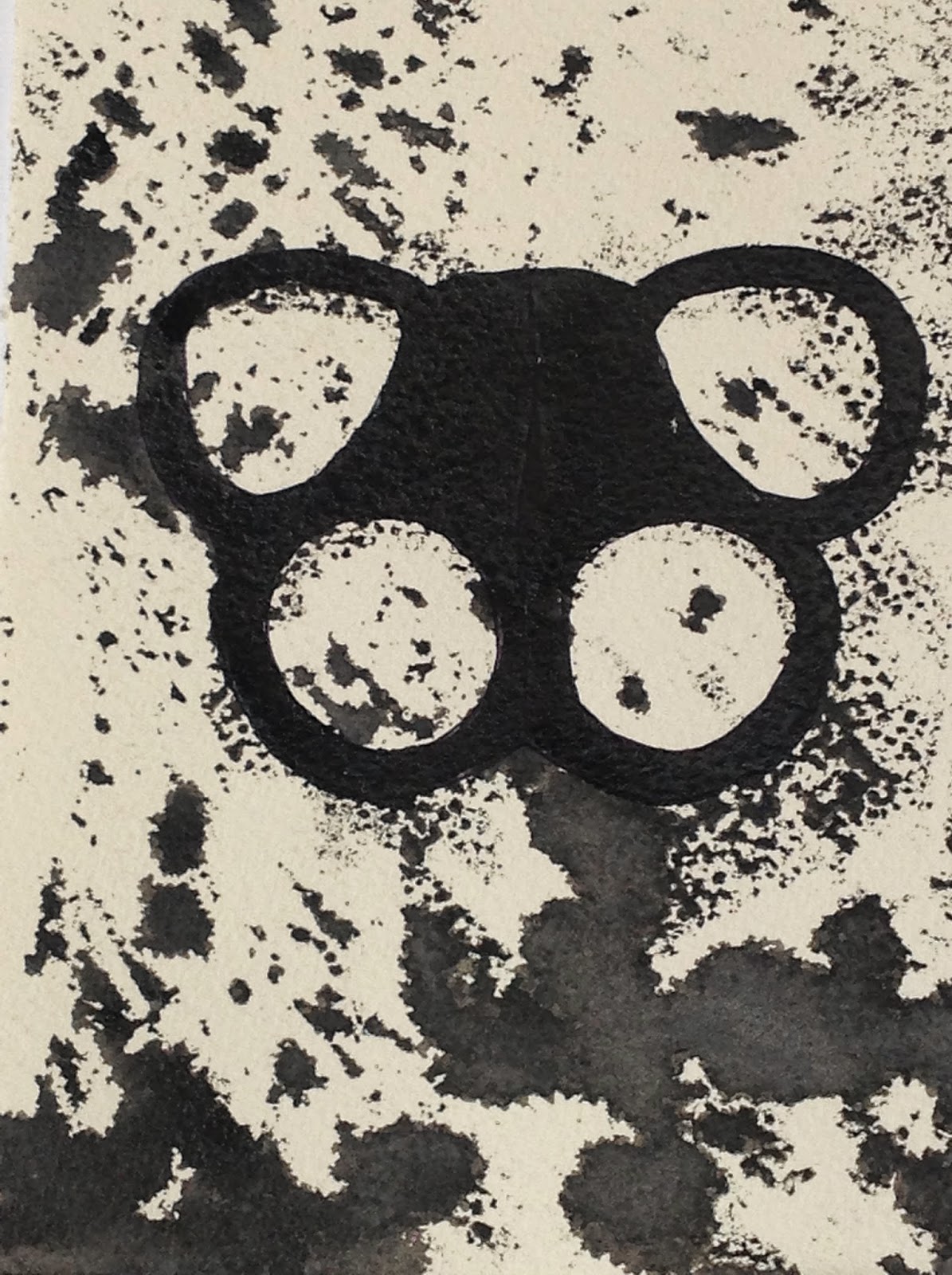Saturday 28th March - a day spent in the Flexi space at Dartmouth Avenue in order to experiment with presentation concepts. It is a good clear space with white walls and few windows. There were two free standing lights which were available to use. I took a few photographs using this additional lighting but felt they were not successful and tended to spotlight small areas, create shadow. The photographs are of a poor quality taken with an Ipad and enhanced in Photoshop Elements.
The emphasis in relation to this exercise was essentially about form, shape and format, the quality of the photography was not a priority.
There were six frottages in total, taken from two Oak trees and various papers had been used. Five were made using varying thicknesses of lining paper and one was made on Fabriano white 120gsm paper. This created a subtle variant in colour and by placing direct on the floor presented an anti-aesthetic giving a perception of being stored as well as having a direct contact to the ground and the horizontal. I believe the dynamic re storage would change if they were moved away from the wall. Overall, I perceive this as an understated Eastern aesthetic, free of constraints, without status. The shape reflects the vertical of the tree. The presentation could further be extended by varying the shape of the cylinders and experimenting with spacing/grouping. When placed on the table the dynamic changed creating an appearance that was less solid and disconnected.
Enso (Zen Circle) and Calligraphy by Rankeisai, Japanese.
18th century (Edo Period). Hanging scroll, ink on paper
The circular shape also echoes the sign of 'Enso', a concept that is used extensively in Zen Buddhism. It is the idea of the circle or incomplete circle painted in one stroke. This icon is very prevalent in Japan and is meant to resemble enlightenment, strength, elegance of the universe, and the void or the space that connects everything, it can also symbolize the Japanese aesthetic itself. The frottage cylinders can be presented with ends folded in reflecting on the incomplete circle. Here the opening suggest that the enso is not separate, but is part of something greater, or that imperfection is an essential and inherent aspect of existence. It also reflects on the idea of broken symmetry where the principle of controlling the balance of composition through asymmetry and irregularity is an important aspect of the Japanese aesthetic.


 |
This form extended visual perspectives, creating varying heights and a view inside the rolls which could be seen to reflect the age circles of a tree. Again an anti-aesthetic approach which could be presented on the floor.
|


More formats were explored and presented on the table in the above four images. I felt all of these detracted from the simplicity of form with the arrangements becoming far too complex. Overall they appeared disjointed, uncomfortable - trying too hard to be something else!.


These two frottages have been made using heavyweight lining paper. Taken from the same mature oak tree the mark making is strong with good contrast. The numerical reference of the number 2 in Zen Buddhism represents our mundane understanding of reality, as reflected in our focus on duality. There are also "2 Truths", relative truth and absolute truth, the former referring to mundane reality and the latter to transcendental reality. Within Christianity the number 2 is also very significant as with the second creation by God of light - hence dark and light. The second number of anything speaks and implies the differences that exist. Presenting these on the plinth gave a 360 degree access to the viewer and contained them in a small area creating focus closer to eye level.

 |
| Using four frottages references the significance of the number 4 in both Zen Buddhism and Christianity. It represents the four noble truths in Buddhism, the four gospels in Christianity. In addition creation occurred on the fourth day; there are four seasons, there are four natural elements, four phases of the moon, etc. |
  |
Hung high on the wall, a vertical scroll interpretation which connects to the ground. Simple and effective presentation which engages on several levels, i.e. scale, expanse and variance of marks, echoes the vertical of viewer providing a direct physical connection. This has been a presentation aesthetic used in Eastern art. Hanging scrolls are known as Kakemono in Japanese and translates as 'hanging object'. They are said to have originated at the time of the Tang dynasty in the seventh to ninth centuries and developed from similar sutra scrolls. Vertical and horizontal scrolls were created in order that they could be easily rolled up and transported. Alongside the geographical of Japan with its high incidences of earthquakes, works of art were less likely to be lost or damaged. They have had strong connections with the Tea ceremony but over the course of history have come to be appreciated more for their aesthetic qualities.
(Space in Japan was limited, they did not have the luxury of huge expansive walls to hang grand paintings or access to oil paints and canvas as in the West. These materials were not introduced until the 19th century when Japan opened up to the West and there was a cross cultural exchange and influence of Eastern and Western art).
Although the four 'scrolls' created an impact by sheer scale I preferred the format of two which was more powerful, four somewhat diluting by overstating - less was more in this instance.
|
 |
|
Close up section of hanging scroll. The left hand image reflects elements of traditional Japanese brush and ink landscapes. These two works present strongest contrast in colour.





















































